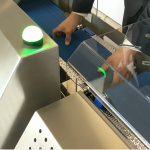Necessity, as the saying goes, is the mother of invention. In 2020, manufacturing had to cope with the consequences of a global pandemic, unpredictable markets, and political instability, all while dealing with pressing issues that were already troubling the sector before, such as the need to form sustainable production practices. Here Neil Ballinger, head of EMEA at EU Automation, offers an overview of three sectors where the difficulties of 2020 have originated new opportunities for 2021.
Each month, the Oxford English Dictionary tracks the top 25 keywords in the Oxford language corpus, monitoring spikes and surges in frequency. Unsurprisingly, 2020 has been literally defined by COVID-19, with terms like pandemic, quarantine and lockdown featuring almost every month.
But how have manufacturers responded to the doom and gloom of 2020? The sector has proven to be not only resilient, but ready to adapt and eager to innovate. As a result, strategies that manufacturers implemented to merely stay afloat in 2020 might turn into the winning formula for a successful 2021.
Advanced robotics
In 2020, many manufacturing plants found themselves with emptied premises, due to shutdowns or to the necessity to stagger shifts or move part of their workforce to remote working. Plants, however, required the usual amount of upkeep, plus extra services such as daily deep cleaning and even extra maintenance for equipment pushed to its limit to meet spikes in demand or make up for lost productivity.
To do all this while reducing on-site personnel, companies have increasingly turned to robots, with the consequence that stock prices for advanced robotics soared in 2020. Companies such as ABB saw their share prices increase, while Brain Corp experienced a sudden increase in demand for its floor-cleaning robots.
This trend will likely continue in 2021, with companies purchasing advanced robots to automate routine tasks while continuing to comply to social distancing regulations.
Reliable supply chains
Remember the days when toilet paper and hand sanitiser were luxuries? During lockdown, people worldwide have experienced first-hand the consequences of complex supply chains that heavily rely on one geographical area.
To prevent this from happening again, manufacturers will likely seek to eliminate single-source dependencies by diversifying their supply chains in 2021. We will witness a shift from global to regional sourcing, with manufacturers sourcing raw materials closer to home and producing components, which were traditionally outsourced for manufacturing, in-house.
Companies will also need to invest in inventory management solutions that provide visibility across all nodes of their supply chains, beyond their tier-1 suppliers. In this way, manufacturers will be able to react quickly if one node is unable to fulfil an order.
Supply chain management will also see a decline in popularity of historical statistical models to predict demand. These models consider unpredictable events, such as a pandemic, as outliers and discard them from their data. In today’s unpredictable world, this is no longer a viable option.
Producing sustainably
In 2020, lockdown gave nature a chance to reclaim its spaces — footage of wild animals cruising town centres undisturbed was everywhere in the news.
In 2021, pressure from consumers and governments will push manufacturers to intensify their efforts to produce sustainably. Recent HIS Markit research shows that the pandemic has reinforced existing policies to decarbonise industry, with the European Union, the UK, Canada and China leading the way.
Sustainability will also be at the core of investors’ agendas. According to the International Renewable Energy Agency, total investment in renewable power sources will exceed investments in fossil fuels for the first time in history.
An increasing number of global corporations are also advocating for sustainability — Apple, for example, announced in July 2020 that it is expecting to make all its supply chains and products carbon neutral by 2030. In 2021, a growing number of companies are expected to launch similar initiatives.
While 2020 was the year of challenges, 2021 might be the one of opportunities — EU Automation has stood by manufacturers’ side during the most challenging moments of the pandemic, and will continue to do so in the year of rebirth.





